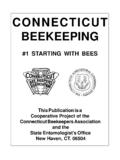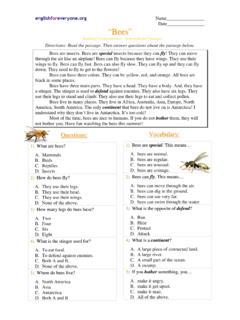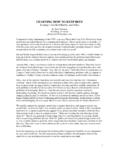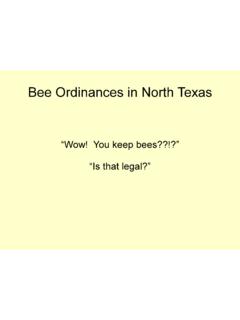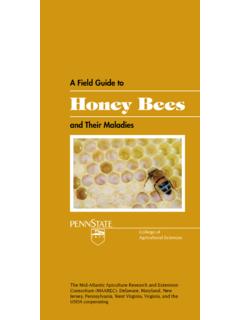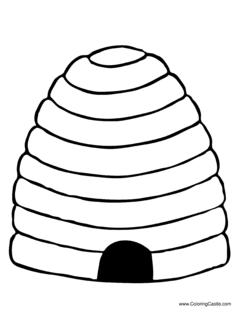Transcription of FARMING FOR BEES - xerces.org
1 FARMING FOR BEESG uidelines for Providing Native Bee Habitat on Farms The Xerces SocietyFOR INVERTEBRATE CONSERVATION Mace Vaughan, Jennifer Hopwood, Eric Lee-M der, Matthew Shepherd,Claire Kremen, Anne Stine, and Scott Hoffman BlackFARMING FOR bees Guidelines for Providing Native Bee Habitat on FarmsMace VaughanJennifer HopwoodEric Lee-M derMatthew ShepherdClaire KremenAnne StineScott Hoffman BlackThe Xerces Society for Invertebrate ConservationOregon California Minnesota NebraskaNew Jersey North Carolina 2015 by The Xerces Society for Invertebrate ConservationThe Xerces Society for Invertebrate Conservation is a nonprofit organization that protects wildlife through the conservation of invertebrates and their habitat.
2 Established in 1971, the Society is at the forefront of invertebrate protection, harnessing the knowledge of scientists and enthusiasm of citizens to implement conservation programs worldwide. The Society uses advocacy, education, and applied research to promote invertebrate Xerces Society for Invertebrate Conservation628 NE Broadway Ste. 200 , Portland, OR 97232tel fax offices in California, Minnesota, Nebraska, New Jersey, North Carolina, and Xerces Society is an equal opportunity employer and thank the Alice C. Tyler Perpetual Trust, Audrey & Martindale Foundation, Columbia Foundation, Cascadian Farm, CS Fund, Ceres Trust, Cinco, Clif Bar Family Foundation, Disney Worldwide Conservation Fund, The Dudley Foundation, Edward Gorey Charitable Trust, The Elizabeth Ordway Dunn Foundation, Endangered Species Chocolate LLC, Gaia Fund, General Mills, Irwin Andrew Porter Foundation, Richard & Rhoda Goldman Fund, Organic FARMING Research Foundation, Panta Rhea Foundation, Sarah K.
3 De Coizart Article TENTH Perpetual Charitable Trust, Swimmer Family Foundation, Turner Foundation, Inc., the USDA Natural Resources Conservation Service, The White Pine Fund, Whole Foods Market and their vendors, Whole Systems Foundation, and Xerces Society members for their generous financial support that led to the production of these goes to our fantastic group of farmer-partners for helping to build upon our experience, and for graciously allowing us to highlight their great conservation work in case studies and photos, including Vilicus Farms, East Multnomah Soil and Water Conservation District s Headwaters Farm, the Kerr Center.
4 The Muir Glen Organic team at General Mills, Brian and Rhoda Gibler, DeLano Farm, Hedgerow Farms, Inc., Tadlock Farms, Sturm Berry Farm, the University of California Davis Sustainable Agriculture Research Facility, Whitted Bowers Farm, Chet Halunen at Standish Bogs, and Omeg Orchards. We also thank the following contributors who helped by reviewing early drafts of these guidelines:Robbin Thorp, University of California Davis; and Sarina Jepsen and Katharina Ullmann, the Xerces Society. We also would like to thank all of the scientists conducting field research on crop pollination by native bees . Without the support and hard work of these scientists and reviewers, this guide would not have been : Kara West, Sara Morris, and Matthew Shepherd.
5 Layout: Sara : Print Results, Portland, : front pollinator planting adjacent to blueberry farm (photograph by Don Keirstead, New Hampshire NRCS); back bumble bee covered with pollen (photograph by Nancy Adamson, The Xerces Society).We are grateful to the photographers for allowing us to use their wonderful photographs. The copyright for all photographs is retained by the photographers. None of the photographs may be reproduced without permission from the photographer. If you wish to contact a photographer, please contact the Xerces Society at the address above. Additional copiesA copy of these guidelines may be downloaded for free from the Xerces Society website, available at: Hard copies are also available for purchase through the Xerces Store at: Edition (revised)First published in 2004.
6 The second edition was published in July 2007, and the third edition was published in December 2011. This fourth edition revised reprint was published in January BASICS1 Introduction 12 What Are Native bees ? 3 Some of the Many Crop-Visiting bees 53 Why Farm for Native bees ?
7 7 Native bees Are Very Efficient 7 Native bees Are Diverse and Stable 8 Native bees May Provide Additional Revenue 8 Native Bee Habitat Supports Health of Managed bees 9 Pollinator Habitat Provides Other Benefits 9 Case Study.
8 Pollinator Conservation Brings Life Back to California Farm 10 CONSERVATION ACTION4 Three Steps to Success 12 Recognize Resources Already on the Farm 12 Adapt Existing Farm Practices 14 Provide Habitat for Pollinators on Farms 15 Case Study: Leveraging Existing Natural Areas for Blueberry Pollination in Oregon 165 Where to Provide Habitat 18 Potential Areas for Bee Habitat on Farms 18 Site Characteristics to Consider 21 Case Study.
9 Integrating Pollinator Habitat into Dryland Fields 246 Creating Foraging Habitat 26 Plant Selection 26 Establishing Pollinator Habitat 30 Choosing Garden Plants 33 Planting Forage Cover Crops 34 Consider bees When Rotating Crops 36 Case Study.
10 North Carolina Farm Sets the Stage for Pollinators 377 Protecting and Creating Bee Nest Sites 38 Nesting Sites for Ground-Nesting bees 38 Nests for Wood- or Tunnel-Nesting bees 40 Bumble Bee Nests 44 Case Study.



